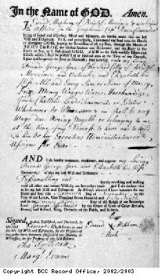How were the crew treated?
Slave ships’ captains had a reputation for hardness. This varied from ship to ship, but the captain did have absolute power over the ship and his men. The captain could whip, flog and otherwise punish crew members as he wished. Even minor faults could be harshly punished by the captain.
Many of the crew could not read or write. The sailor, Edward Mapham, wrote his will before he sailed for Africa on the ship the Greyhound in 1749. He left all his belongings and money to his friends George and Elizabeth Gore. The sailor signed the will with a cross as he was unable to write his own name. Even the more educated members of the crew could do little against a bad captain. Two Bristol seamen who suffered at the hands of very cruel captains were able to write about their experiences. Sailors Robert Barker and Silas Told both published accounts of their experiences onboard slaving ships, telling how they were treated. Silas Told was punished on one occasion for taking too much bread from the bread store for a meal for the crew. He was whipped so hard by the captain that his clothes were torn to pieces.
The captain could do as he wanted. Often sick men or men whom the Captain disliked were left behind in the Caribbean without their wages or belongings. They would have to beg or starve, or find another ship that would take them. This happened to Robert Dinely, a ship’s surgeon on the Bristol slave ship the Fame, who was ‘maliciously’ left on the Caribbean island of Jamaica.
Occasionally the crew responded to the captain’s cruelty by murdering him or by turning on him. John Westcott was the captain of the Bristol owned slave ship the William in 1767. One of the crew, Stephen Porter, committed an offence, and Westcott beat him severely for it. That night, Porter and another sailor named Hancock killed the captain with an axe and threw his body overboard. They then killed the mate (the captain’s assistant) and took control of the ship. In 1769, the crew of the slave ship the Black Prince rose up against the captain and officers, put them into one of the ship’s small boats and left them floating adrift in the ocean.
Many crew members often became ill on the West African coast. Being from Europe, the sailors were not used to the tropical diseases found in this part of the world, such as malaria. At the time of the transatlantic slave trade, no cure for malaria had yet been discovered. Conversely, the enslaved Africans were not used to European diseases, and the sailors would spread measles and smallpox amonst them. A number of sailors went blind, either from fever or from looking directly into the sun (which sailors did to find the position of the ship at sea). The death rate amongst the crew on board the ships was very high. On the slave ship the Jupiter seven men out of the 46 died. One man drowned, the other six died from ‘the fever’ (probably malaria) or ‘the flux’ (either gastroenteritis or dysentery, which spread quickly in the cramped conditions on board ship). What is often forgotten about the sailors, is that those men who died might have left behind people who were financially dependant on them. Mothers, widows and children of dead sailors would have been left poorer by the loss. Surviving letters written by the relatives show that they often had difficulty in getting the sailor’s wages and possessions back from the ship’s captain.
The sailors on board the slave ships were supposed to be given certain provisions each day, such as food and water. It was up to the ship’s captain to make sure that this happened. The contract signed by the sailors before joining each slaving voyage was called the ‘Articles of Agreement’. This contract shows what the crew of the slave ship the Fame were to get on the 1790 voyage. It was a pound and half of beef (about 700g) and half a pint of flour (about 200g) on Sundays. On Tuesday they had two ounces of butter (about 60 g) and four ounces of cheese (about 120 g) as part of the day’s food. In addition, the crew were to be given six pounds (about 3 kilos) of bread each week, and a quarter of a pint (about 100 ml) of spirits or half a pint of wine (about 200 ml) every day.
The crew were forbidden, in their agreement, to treat the slaves badly. Sometimes the slaves were violent, in which case the sailors were allowed to respond using any necessary force. However, it is clear from records that captains and ships’ officers routinely raped female slaves. It is also known that the slaves were often severely punished for minor offences by the captains. On ships which were poorly run by the captains, sailors themselves may have been able to abuse the slaves.
The death rate amongst the crew of slaving ships was high. This discovery shocked the people who started the campaign for the end of the slave trade. They had thought that it was only the slaves who tolerated awful conditions and were cruelly treated by the ship’s captains and officers. But the death rate amongst the enslaved Africans in the holds of the ships was also high. The cause of death was usually sickness. The enslaved Africans were exposed for the first time to common European diseases such as measles and smallpox, carried by the crew. In the cramped conditions of the ships, serious stomach upsets such as gastroenteritis and dysentery could spread quickly. One or two deaths out of every 10 slaves was common on a voyage. It could be more, or it might be less. On that same voyage of the slave ship the Jupiter, some 28 out of the 299 enslaved African men, women and children died on board.



